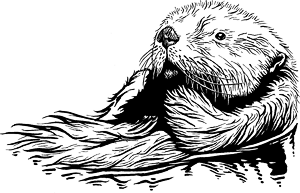Sea Otter Biology and History in the Aleutian Islands

Although sea otters live in cold ocean waters, they don’t have a layer of fat or blubber like whales, seals, and sea lions. But they have one of the thickest fur coats of any animal, with 1,000,000 hairs to the square inch. By comparison, humans have only 100,000 hairs on their head. In fact, what keeps the otter warm is a double fur coat. The fine underfur next to the body traps heat, and very long guard hairs on top of that keep the underfur dry.
In rocky areas, sea otters prefer to spend most of their time in tall, thick beds of brown seaweed, or kelps. They wrap themselves up in the kelp to help them stay afloat when they rest and sleep. Inside the kelp stand, the waves are much gentler.
Sea otters have a favorite food in rocky areas—sea urchins. The otters dive down to the bottom of the kelp where the urchins are feeding, and they can stay under water for five minutes. They also eat snails and fish.
People harvest sea otters for their fur. The Unangans, some of the first Native people from Asia to reach Alaska, lived for thousands of years in the Aleutian Islands. They made warm, full-length coats, or cloaks, from the warm, luxurious fur of the otters. In 1741, Vitus Bering reached the Aleutian Islands and took sea otter pelts back to Russia. A large fur trade by Russians, Americans, and British killed nearly every sea otter in the Aleutian Islands by the late 1800s. In 1911, however, the sea otters were protected by an international treaty and they began to slowly recolonize the entire chain of islands. Visitors to the Aleutian Islands like to see and photograph the otters.
Sea otters spend a lot of time keeping their fur coat clean. If the fur becomes dirty, the sea otter is no longer waterproof and it will drown. Oil spills are especially dangerous to sea otters because the oil coats the guard hairs. When the otter cleans its fur, it swallows large amount of oil that can make it sick or kill it.




